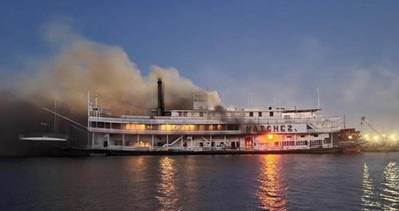Combustible Materials Near Hot Work Sparked Passenger Vessel Fire -NTSB
A fire that broke out aboard a Mississippi River cruise vessel was found to be caused by combustible materials left unprotected near hot work, the National Transportation Safety Board (NTSB) said Tuesday.
The passenger vessel Natchez, used by the New Orleans Steamboat Company for daytime and dinner jazz cruises daily from the French Quarter in New Orleans, was moored and out of service when it went up in flames on May 3, 2022. The fire resulted in $1.5 million in damages to the vessel, and no pollution or injuries were reported.
The Natchez had been undergoing renovations since January 2021 for an extensive overhaul, with a goal to return to service in 2023. On the day of the fire, contractors were removing the vessel’s main electrical panel to install a replacement. After work was completed for the day, the Natchez deckhand serving as the security watchstander saw smoke and flames in the engine room. The New Orleans Fire Department extinguished the fire. Most fire damage was contained within the generator space that housed the panel, with minor heat damage to the engine room and minor smoke damage to the external passenger decks located directly above the fire.
The Bureau of Alcohol, Tobacco, Firearms and Explosives determined the fire originated near the deck along the forward bulkhead, adjacent to where the hot work was performed. NTSB investigators saw photos taken prior to the fire that showed cardboard boxes, wooden shelves and other combustible were in the storage areas near where the hot work was performed.
Neither the vessel owner nor the hot work contractor had a written safety policy or procedures in place for employees to review and follow when preparing for and conducting hot work on the vessel, NTSB investigators found. Fire safety plans are required by the Occupational Safety and Health Administration (OSHA) regulations.
The NTSB determined the probable cause of fire was the failure of contractor and vessel personnel to identify and then either remove or adequately protect combustible materials near hot work.
“The NTSB has investigated multiple fires following the completion of hot work within a space that were determined to be caused by a smoldering fire,” the report said. “A smoldering fire is formed when combustible material ignites, but the combustion proceeds slowly and steadily on the material’s surface with little heat and no smoke or flame. A smoldering fire is not easily detected, and depending upon its surroundings, it can last for hours after the initial ignition and can quickly grow into a flaming fire with no warning. It is critical to evaluate work areas for fire hazards and ensure that combustibles are relocated or protected with flameproofed covers/curtains or otherwise shielded with sheet metal. In addition, crewmembers involved in hot work should be trained to identify hazards such as combustibles and to take action to remove or protect them from hot work.”












